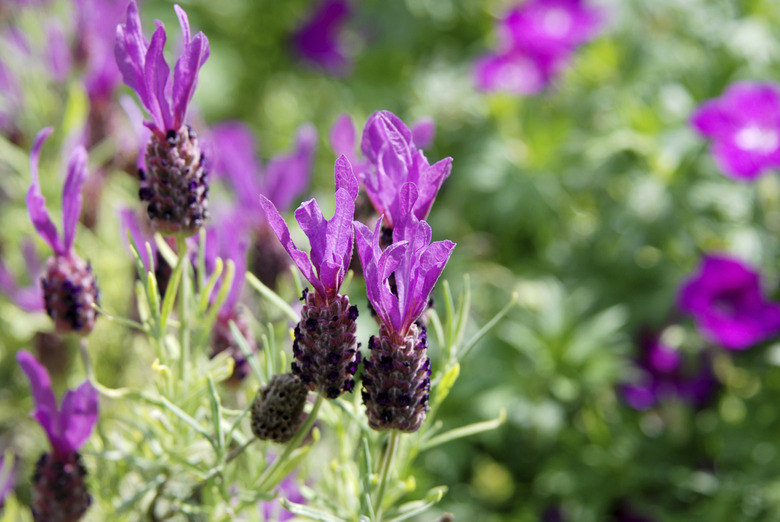How To Grow Spanish Lavender
We may receive a commission on purchases made from links.
For a fragrant addition to an herb garden or flower border, Spanish lavender (Lavandula stoechas) is hard to beat. Sometimes called "rabbit ears" because of the shape of its bloom spike, Spanish lavender is a perennial in U.S. Department of Agriculture plant hardiness zones 7 through 9 and is adaptable to most conditions, including hot, humid weather. This is an easy-to-grow plant that only needs some basic care at planting and a bit of extra care and pruning to keep it doing well.
Spanish Lavender Planting Basics
Spanish Lavender Planting Basics
Sow Spanish lavender seeds indoors during the winter in a lightweight, soil-less mix or fine vermiculite to ensure good drainage. Seeds germinate in about two weeks. Keep seedlings in a sunny spot and water them whenever the top of the mix is slightly dry.
When the weather warms and the temperature stays above about 60 degrees Fahrenheit, harden off seedlings by moving them into a partially shaded, sheltered spot for a week or two before planting. For less fuss, purchase Spanish lavender seedlings for planting directly in the ground.
Mature plants are bushy and 1 1/2 to 3 feet tall, so space them about 18 to 24 inches apart to give plants room to fill out without crowding. Spanish lavender also grows well in a container, but choose one that has one or more drainage holes, and never leave the saucer filled with water.
Sun, Water and Soil
Sun, Water and Soil
Spanish lavender flowers resemble small, dark maroon pineapples topped by several modified leaves called bracts, which are the rabbit ears. The plant needs full sun to grow well and produce the most flowers. Although it's quite tolerant of drought once established, flowering depends on a good supply of soil moisture, so don't let the soil dry out at all. Give it supplemental water as needed when rain is scarce.
Spanish lavender is native to Mediterranean and North African regions with poor soil and does best without any fertilization, but it requires excellent drainage for good growth. If the soil is high in clay and drains slowly, amend the soil with organic matter at planting to improve its drainage.
Mulching, Harvesting and Pruning
Mulching, Harvesting and Pruning
Adding mulch to the soil around Spanish lavender plants helps keep down weeds that can compete for soil nutrients and water. Keep mulch back a few inches from the each plant's base and use a nonorganic mulch such as pea gravel to deter fungal growth.
Harvest lavender as cut flowers or for drying once blossoms show deep color, cutting stems during the cool morning hours once dew has dried from the plants. Keep flowers cool and out of the sun to preserve their fragrance. Wipe cutting blades on your pruning shears with rubbing alcohol between each cut to prevent the spread of plant disease.
Pruning Spanish lavender regularly helps encourage branching and a second flush of flower buds. Remove about one-third of each plant's stems, being careful not to remove all leaves. Cut off any remaining spent flowers.
Problems and Winter Care
Problems and Winter Care
Like other lavenders, Spanish lavender is usually free of insect problems, although it might attract spittle bugs, named for the frothy secretions that betray their presence. They can be unattractive, but spittle bugs cause little or no harm to the plant.
Spanish lavender is rarely troubled by any plant diseases except fungal problems. To prevent fungal issues, place the plant where air circulation is good, and water at the plant's base to keep foliage dry.
When the growing season ends in fall, avoid pruning the plant. Leaving old growth in place helps protect it from winter weather. In especially cold areas, add evergreen boughs as an extra mulch to prevent damage from the elements.
